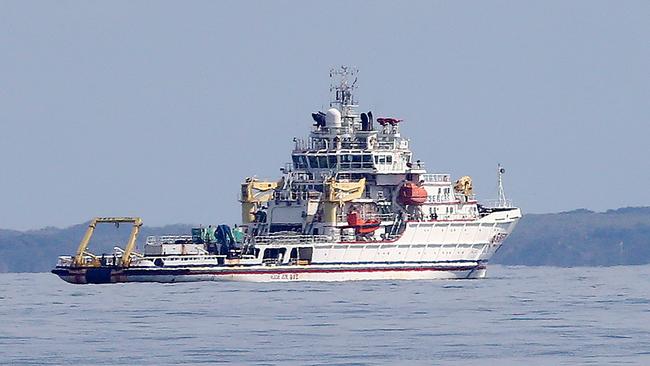Chinese MH370 search vessel ‘not looking but spying’
The Chinese ship hunting for MH370 has done little searching but has probably been spying, security experts say.

The Chinese government ship tasked with hunting for Malaysia Airlines flight MH370 has done little searching but has probably used the opportunity to spy on Australian military activity, according to security experts.
Its captain and crew are also likely to have used interaction with Australian and international experts to acquire knowledge of advanced Western underwater search techniques and equipment, and tested out submarine tracking technology.
As revealed by The Australian earlier this month, the Chinese search and rescue vessel Dong Hai Jiu 101 has hardly performed any actual search operations in the seven months since it first came to Fremantle.
The federal government’s Joint Agency Co-ordinating Centre, which guides the strategy for the MH370 search, this week again refused to say how many days the Dong Hai Jiu 101 had conducted search operations.
But an analysis by The Australian of weekly operational bulletins on the search put out by the JACC has determined that the vessel’s sonar imaging “towfish” has in fact been in the water looking for the downed aircraft between only 17 to 30 days.
The Dong Hai Jiu 101 has spent most of the time in or just off Fremantle for one stated reason or another, or on “weather standby” in the southern Indian Ocean or “north of the search area”.
It gave up attempting to search altogether in early August, when the JACC reported the ship would “remain at anchor off Fremantle until weather conditions improve”.
The Dong Hai Jiu 101 is a major component of China’s $20 million contribution to the $180m effort to find the Boeing 777, which disappeared on a scheduled flight from Kuala Lumpur to Beijing on March 8, 2014 with 239 people on board, ending up in the southern Indian Ocean, according to satellite tracking data.
In April, Transport Minister Darren Chester joined the Chinese Consul-General in Perth, Lei Kezhong, on a visit to the ship.
“On behalf of the Australian government, I thanked the Chinese government for its contribution and the captain and crew for their efforts in the search for MH370,” Mr Chester said in a press release at the time.
Leading security experts told The Australian that as a Chinese government vessel, as a matter of course the Dong Hai Jiu 101 would be monitoring Australian and allied military activity.
Western Australia is home to the Australian submarine base near Perth at HMAS Stirling; the Special Air Service Regiment also in a suburb of Perth; the Australian Defence Satellite Communications electronic spying station at Kojarena near Geraldton; and the North West Cape naval communications station near Exmouth.
“From my past intelligence experience I would be surprised if a vessel like the Dong Hai Jiu 101 did not have an intelligence collection role,” said Clive Williams, a former Australian army officer who was Director of Security Intelligence.
“WA is of course a target-rich environment in terms of various Australian defence activities,” said Mr Williams, who now teaches at the Australian National University.
“China’s intelligence collection effort against Australia goes back at least 30 years. China also has an active collection effort within Australia as documented by defectors. The People’s Liberation Army Navy has a strong interest in the Indian Ocean where ‘research’ activity is conducted by Chinese ships including its hospital ship, the Peace Ark.”
Australian Strategic Policy Institute executive director Peter Jennings said the Dong Hai Jiu 101 “isn’t purpose built to be an intelligence-gathering ship”.
“That said, this ship would as a matter of routine be noting any activity into and out of Fremantle and HMAS Stirling, which all adds to a database of ship movements and observed capabilities,” Mr Jennings said.
“I would say that the real value of the Dong Hai Jiu 101’s activities is that it is … learning first-world techniques, tactics and procedures on how to do search and rescue.
“The PLA-N (and other Chinese maritime units) has been lifting its skill levels through activities like this as well as counter-piracy operations off the Horn of Africa; extended deployments and exercising.”
Greg Barton from Deakin University said the Dong Hai Jiu 101 would probably be spying “as a matter of course”.
“Apart from actual intel, it would also represent an opportunity to gauge their signals intelligence capacity in terms of working out what they can pick up at that sort of distance, such as working out how well their hydrophone instrumentation can track submarine movements,” he said.
The JACC did not respond to a question from The Australian about whether the Dong Hai Jiu 101 might be spying.
In a statement. the JACC, which works with federal agencies and departments including Foreign Affairs and Defence, said: “Dong Hai Jiu 101 has been available for search operations since February 25, 2016. The crew of approximately 30 remain on board the vessel when it is at anchor.”
The Chinese embassy in Canberra, and the Chinese consulate in Perth, did not respond by deadline to a request for comment.



To join the conversation, please log in. Don't have an account? Register
Join the conversation, you are commenting as Logout